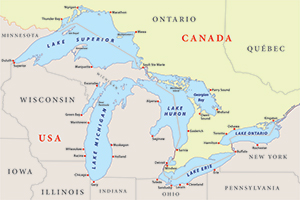Silence is Not the Answer in Clean Water Act Attack
(Updated September 2021)
In my role as Product Segment Manager for Outdoor Water Quality at YSI, a Xylem Brand, I spend most of my professional days keeping my ear to the ground for the needs and trends that will drive YSI’s development, improvement, and management of water quality monitoring technologies. It is a role I relish, as it places me at the confluence of science and business development. In the past 10 years, a third stream has entered my professional confluence and turned it into a whirlpool: public policy.
Take for instance how I learned on Saturday, April 13, 2019, that the Environmental Protection Agency and The U.S. Army Corps of Engineers have proposed a rule to alter the definition of WOTUS, Waters of the U.S. Their proposal, available here, was posted on Valentine’s Day, with a closing day for public comments on April 15, 2019. I learned of it on Facebook over tea on my Saturday morning because scientist-friends had posted this letter drafted by a collection of scientific organizations, including the North American Lake Management Society and the Association for the Sciences of Limnology and Oceanography. In essence, this representation of over 200,000 scientists clearly opposes the proposed rule, because it “…is not based on sound science or the best-available peer-reviewed information and will, as a result, exclude numerous waters and wetlands that directly affect the chemical, physical, and biological integrity of primary waters making it impossible to achieve the objectives of the Clean Water Act (CWA).”
The compelling 9-page letter is a must-read if you care at all about water, water quality, and the environment.
It may seem obvious to the average bystander what WOTUS should mean, but in fact, this has been debated for years, and the reason people care is that the definition of what comprises WOTUS impacts what the federal government can regulate. Thus a pretty clever approach by the anti-environmental-regulation lobby is, rather than roll back specific regulations upon which the eye of the public is often focused, change the definitions regarding what is able to be regulated, and then all regulations are weakened in one fell swoop.
One example pointed out in the scientific consortium’s letter and which hit close to my Ohio-based-friends regarded the definition of the term “tributary” and how the Proposed Rule (Docket ID No. EPA-HQ-OW-2018-0149) could impact the cherished Great Lakes.
On page 4177-4178 of the Proposed Rule, three major changes to the definition of “tributary” are put forth:
- That a tributary is only a perennial water,
- That a tributary originates from a particular source, and
- That a tributary’s definition should focus on “seasonal flow” rather than “intermittent flow.”
Authors of the science consortium’s letter make clear that, in keeping with science-based conclusions, a tributary should not be defined as only perennial water, it should not be restricted to a source, and the focus on “seasonal flow” is unacceptable as well. As they state,
“The point is that the water flowing in a tributary contributes to the downstream waters, and therefore contributes to the chemical, physical, and biological integrity of those downstream waters and that this relationship (based on chemical, physical and biological [aka ecological] connectivity) is the justification for regulating the tributary.”
In other words, the changes of the definition of “tributary” in the Proposed Rule could render key waters unreachable by regulations of things like industrial discharges and agricultural runoff—major issues affecting the Great Lakes.
For example, the term “headwater stream” is sometimes used to describe small tributaries, and these often dry up during certain seasons. To the untrained eye, a headwater streambed may look like a dry depression in the landscape, something to be filled during construction or used as a place to discharge waste. In reality, whether wet or dry and at all times of the year, headwater streams and streambeds are critically important habitats for wildlife, provide flood protection, and, like wetlands, filtration to ensure water quality downstream. If wetlands are the kidneys of the environment, headwater streambeds might be thought of as the renal arteries and veins.

A sand path along the edge of Lake Michigan.
The Great Lakes, containing 20% of the world’s fresh water, will be impacted if protections of tributaries are rolled back by changing how we define “tributary.” The environmental impacts include the hastening of the extinction of protected species, but there are also economic impacts, as commercial and recreational fisheries would be negatively impacted, and cultural impacts, as some of these same fisheries are of immense value to Native Americans and all sportsmen. As a scientist who has observed how the degrading water quality of the Great Lakes has led to massive algal blooms over the past 10 years, I am aware that their massive size is no longer sufficient to insulate the Lakes from the insults of pollution and climate change. Neither can they be unaffected if we roll back protections of the tributaries that feed them.

Headwaters that ultimately feed the Great Lakes can only be protected if the definition of a tributary is grounded in science, science that the EPA itself acknowledged in its Connectivity Report (EPA 2015) that recognized five parameters of connectivity (hydrologic, chemical, physical, biological and ecological). The proposed change to the definition of a tributary simply has no scientific basis, and is a direct contradiction to that report, as well as the intent of the Clean Water Rule.
I feared that through this post it might be construed that I’m opposing the EPA and the USACE, and frankly nothing could be further from the truth. These agencies are vital to our country, and I respect and know many of the people within them, including some whose names appear on the Proposed Rule. But just like I choose to separate the soldier from the war, I choose to separate my scientist colleagues from the politics. In other words, I support scientists and science-based decision-making when it comes to the environment, even when it is tough to support the activities where the leadership of these agencies might take them. Open and honest debate is always a healthy thing, and that is what I hope to encourage by bringing this Proposed Rule to the attention of our readers.
Finally, I want to point out that learning of this proposal on Facebook really made me feel like I fell asleep on my watch, and had faltered in my vigilance regarding environmental policy. Like everyone else, my information-saturated life gets in the way of my ability to personally follow such developments on an item-by-item basis. Supporting organizations whose mission is in line with my own values about the environment is one way, though, to be vigilant. If I didn’t follow NALMS or ASLO online, or have social media friends who are also passionate about these issues, I would have missed this one. It is also through these professional organizations that many of us have our best opportunity to participate in the legislative process. I’m fortunate that they “had my back” on this issue. However, more active participation is also now a priority, and I did indeed provide my comments on the proposed rule at the Federal Register website.
I chose to comment both in this post and on the Federal Register website because when it comes to protecting water resources,
Silence is not golden.